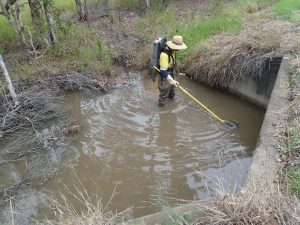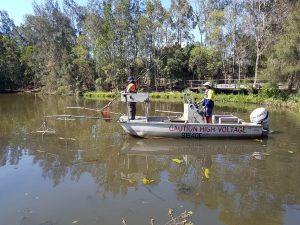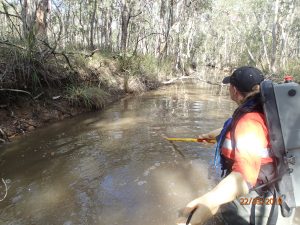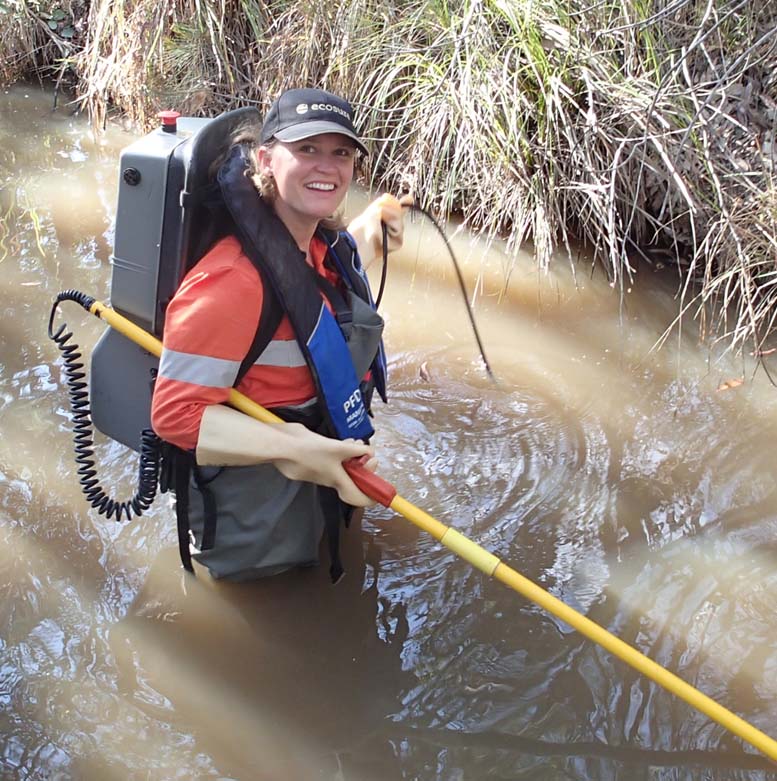Electrofishing is a common fish sampling tool used to understand fish populations in freshwater. Aquatic scientists use electrofishing to gather critical information on fish populations such as abundance, density, species composition, distribution, size class and the presence of invasive species. Electrofishing can be used for a variety of projects, these include aquatic assessments, biological assessments, monitoring programs, native species relocation and targeted removal of invasive species. This tool can be used to gather information on the current state of a waterbody and help determine management and monitoring actions.
How does it work?
There are three main types of electrofishing, backpack, boat-based and bank-mounted. All three are powered by either batteries or a generator to provide an electrical current, they have a control box to regulate the delivery of electricity, positive and negative electrodes that are suspended in the water and safety switches to turn off the power.
Backpack electrofishing is designed for wade-able habitat such as streams, ponds, and wetlands that have low salinity. The electrofisher is carried on your back which allows you to get into spaces a boat couldn’t. Bank-mounted electrofishing have a much higher electrical output, they are powered by a generator mounted in a vehicle and can be used in wade-able habitat. Boat based electrofishing is designed for large, deep areas that are accessible by boat such as rivers and lakes.
Species react differently to electrofishing, an individual’s reaction is determined by the size of the fish, its distance from the electrodes and the orientation of the electrical field. At low voltage, fish experience little to no reaction and may swim away, higher levels of voltage can inhibit swimming by stunning the fish and allowing them to be netted and processed. Fish are stunned for a very short period of time and are able to recover quickly.
The effectiveness of electrofishing is determined by a number of factors, they include the conductivity of the water, depth, turbidity, salinity, the biology and density of the fish species and the weather.
What are the benefits?
Electrofishing allows aquatic scientists to capture a large and diverse sample of fish in a very short time period, it can be used in a variety of habitats, is more efficient, allows greater standardisation of catch per unit and the negative impacts to fish are minimised. Aquatic scientists are able to inspect each fish for injury or disease, measure their size and record their species. Using the information collected from this sample we can estimate species abundance, size structure and condition. This data can be used to influence management actions and tailor monitoring programs for waterbodies.
Who can electrofish?
Electrofishing is a highly specialised and regulated activity that can only be undertaken by a suitably qualified person. All operators must comply with the Australian Code of Electrofishing Practice which involves theory exams, practical training, first aid qualifications and medical examinations.
If you would like to know more about electrofishing, please contact Dr Natalie Toon on 07 3606 1030, or email us at admin@ecosure.com.au.




